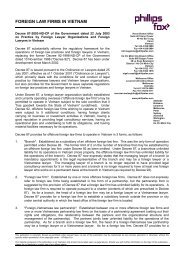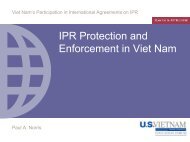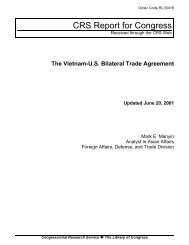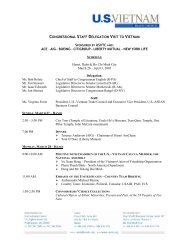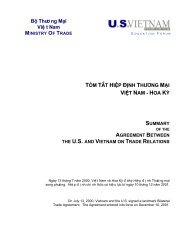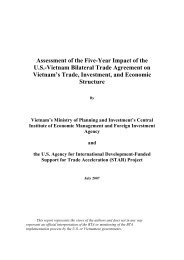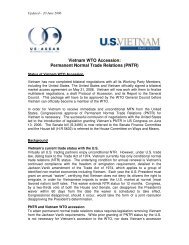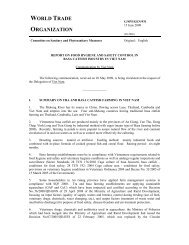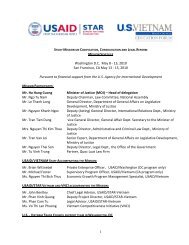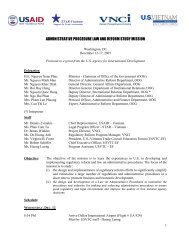Climate risks and adaptation in Asian coastal megacities: A synthesis
Climate risks and adaptation in Asian coastal megacities: A synthesis
Climate risks and adaptation in Asian coastal megacities: A synthesis
- No tags were found...
Create successful ePaper yourself
Turn your PDF publications into a flip-book with our unique Google optimized e-Paper software.
Marik<strong>in</strong>a River areas through a dam, embankments,<strong>and</strong> storm surge barriers. While <strong>adaptation</strong> to climatechange would require significant <strong>in</strong>vestments, <strong>in</strong> thecase of Metro Manila, these are <strong>in</strong>vestments that arealready planned. Thus, climate change <strong>adaptation</strong>would require the government to commit to implement<strong>in</strong>gplans that are currently on the books.Analysis of Damage Costs <strong>in</strong>HCMCHCMC has a long history of extreme weather events.Between 1997 <strong>and</strong> 2007, almost all of the districts ofHo Chi M<strong>in</strong>h City have been directly affected bynatural disasters to some extent. The total value ofdamage to property from natural disasters over thelast 10 years is estimated at over $12.6 million (202billion VND). Most impacts have been concentrated<strong>in</strong> the predom<strong>in</strong>antly rural Can Gio <strong>and</strong> Nha Bedistricts. However, with <strong>in</strong>creased levels of flood<strong>in</strong>g<strong>and</strong> extreme events due to climate change, urbanareas are likely to suffer <strong>in</strong>creas<strong>in</strong>g levels of damage.This is likely to <strong>in</strong>crease costs significantly.The HCMC study used a different approachfrom Bangkok <strong>and</strong> Manila to estimate the aggregatecosts of climate change impacts to 2050. It does nottake a sectoral approach <strong>and</strong> estimate <strong>in</strong> detail thecosts that will be <strong>in</strong>curred as a result of climatechange. While areas of vulnerability <strong>and</strong> <strong>risks</strong> areclear, there has been no attempt to value specific<strong>risks</strong> directly. Rather, a first approximation of thelikely costs of climate change is undertaken basedon macro data. Further, the HCMC study estimatesthe present value of flood<strong>in</strong>g from the current periodup to 2050. Thus, it presents cost estimates todaythat reflect repeated flood<strong>in</strong>g over a long period oftime. In contrast, the Manila <strong>and</strong> Bangkok studiesestimate the costs of specific s<strong>in</strong>gle events of flood<strong>in</strong>g<strong>in</strong> different scenarios.As discussed <strong>in</strong> chapter 2, the HCMC studyuses two approaches to estimate the costs of climatechange: (1) cost estimates based on expected lostl<strong>and</strong> values; <strong>and</strong> (2) cost estimates based on aggregateGDP loss. To recap briefly, the l<strong>and</strong> valuemethod estimates how climate change may affectthe value of the l<strong>and</strong> stock <strong>in</strong> HCMC. The first step<strong>in</strong> the analysis was to determ<strong>in</strong>e l<strong>and</strong> prices. Thearea subject to flood<strong>in</strong>g both <strong>in</strong> extreme events<strong>and</strong> regular flood<strong>in</strong>g was then determ<strong>in</strong>ed underfuture scenarios us<strong>in</strong>g HydroGIS model<strong>in</strong>g. Onceaverage l<strong>and</strong> price <strong>and</strong> flood<strong>in</strong>g extent <strong>and</strong> durationwere estimated, the relationship between theflood<strong>in</strong>g <strong>and</strong> the decl<strong>in</strong>e <strong>in</strong> the economic value ofthe flooded l<strong>and</strong> was determ<strong>in</strong>ed to calculate thecost of flood<strong>in</strong>g due to climate change. The valueof l<strong>and</strong> affected by flood<strong>in</strong>g is assessed assum<strong>in</strong>gl<strong>in</strong>ear <strong>and</strong> quadratic relationships between floodduration <strong>and</strong> l<strong>and</strong> values. The second approachused by HCMC is to calculate costs on the basis ofexpected losses <strong>in</strong> production (proxied by GDP) dueto climate-change-<strong>in</strong>duced flood<strong>in</strong>g. For each district<strong>and</strong> for each year (2006 to 2050), the annual costof flood<strong>in</strong>g was calculated <strong>and</strong> the discounted costssummed for the whole period to f<strong>in</strong>d the presentvalue of expected lost GDP. In the follow<strong>in</strong>g pages<strong>and</strong> the rest of this report, an average exchange ratefor 2008 of 1 USD = 16302.25 VND is used to convertVietnamese dong to U.S. dollars.Macro level analyses suggest that there willbe significant costs as a result of climatechangeThe study estimates that the losses <strong>in</strong> the economicvalue of l<strong>and</strong> affected by 2050 climate change wouldrange from VND 100,358 billion ($6.15 billion) forregular flood<strong>in</strong>g to VND 6,905 billion ($0.42 billion)for extreme flood<strong>in</strong>g, assum<strong>in</strong>g a quadraticrelationship between flood duration <strong>and</strong> l<strong>and</strong> value(Table 4.13). 56 The HCMC study also reports climatechange costs assum<strong>in</strong>g a l<strong>in</strong>ear relationshipbetween flood duration <strong>and</strong> l<strong>and</strong> values. In thiscontext, the cost of climate change is estimated tobe VND 369,377 billion ($22.7 billion) for regularfloods <strong>and</strong> VND 111,678 billion ($6.9 billion) forextreme events. The highest costs (us<strong>in</strong>g either method)are borne by B<strong>in</strong>h Chanh district, district 9, Can Gio,<strong>and</strong> Nha Be district.56In all estimates, the costs of extreme events are muchsmaller than those of regular flood<strong>in</strong>g because (a) flood<strong>in</strong>gdue to extreme events lasts for a smaller number of daysthan that for regular flood<strong>in</strong>g; <strong>and</strong> (b) the calculation offlood<strong>in</strong>g assumes a return period of 30 years for extremeflood<strong>in</strong>g. The expected value <strong>in</strong> any given year is therefore1/30th of the cost of an extreme event.Assess<strong>in</strong>g Damage Costs <strong>and</strong> Prioritiz<strong>in</strong>g Adaptation Options | 69



